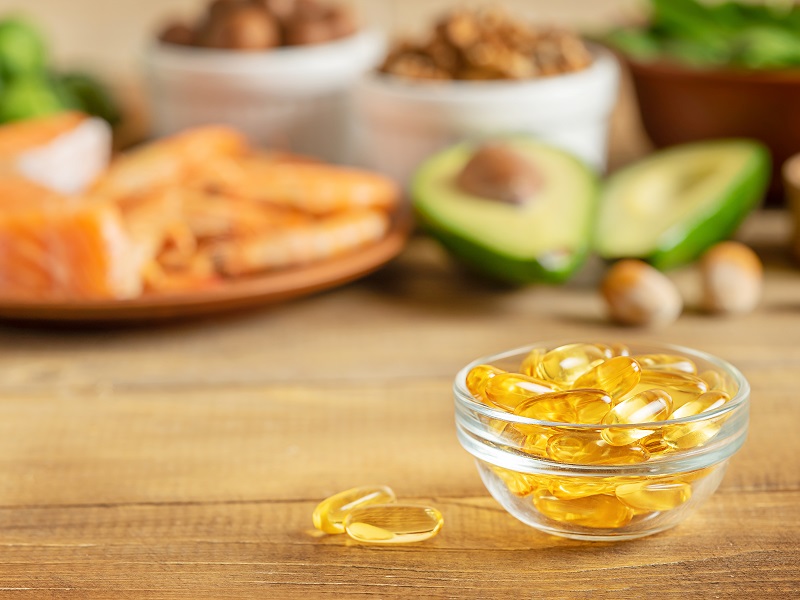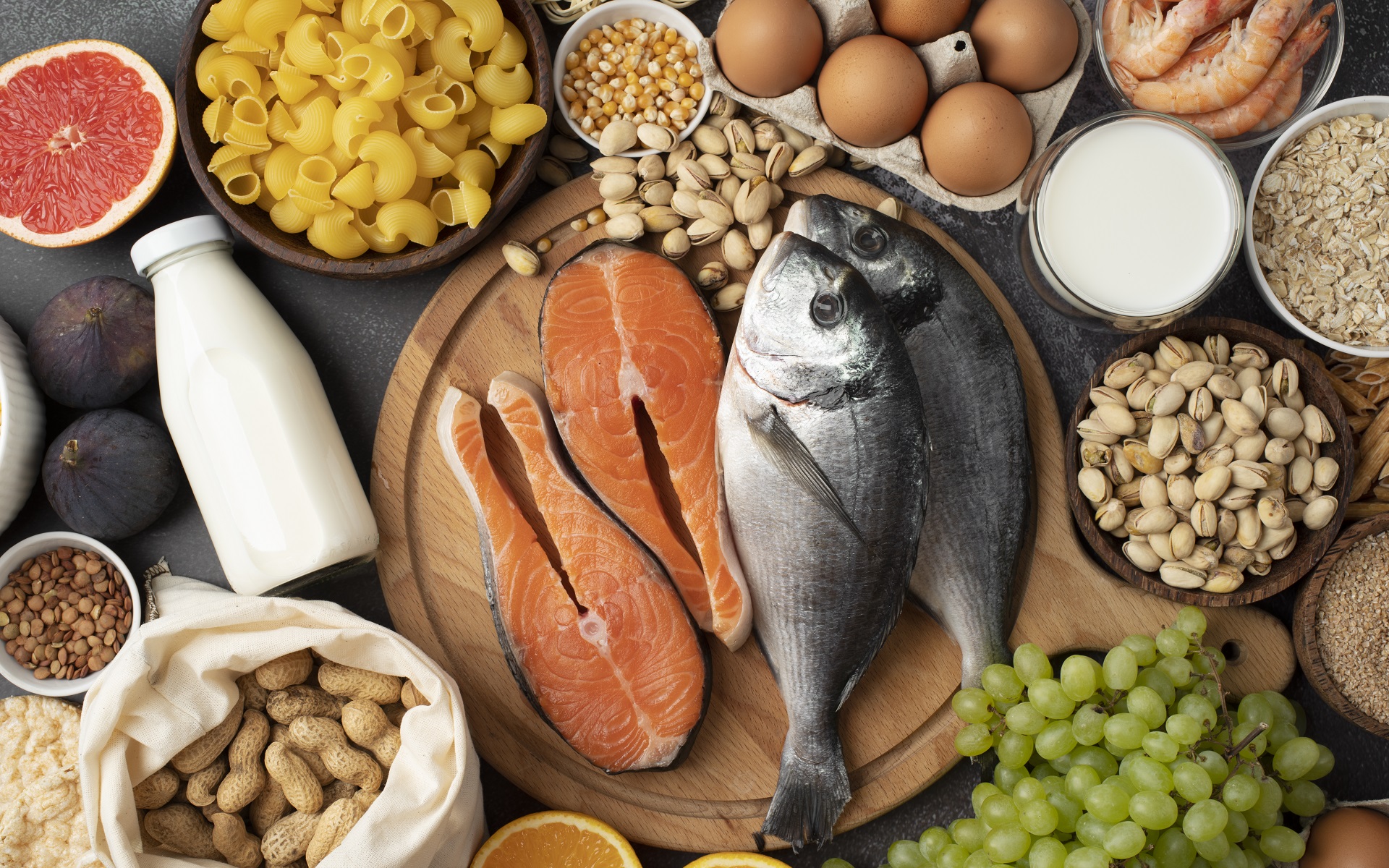Omega-3 fatty acids (LC-PUFA) are among the essential polyunsaturated fatty acids (EFAs), divided into α-linolenic acid (ALA), docosahexaenoic acid (DHA) and eicosapentaenoic acid (EPA). These must be provided with diet or supplementation for optimal body function. It is worth noting that the – ALA form is less efficiently utilised as it needs a series of transformations in the body to form EPA and DHA, which is not always successful, and it is eicosapentaenoic acid and docosahexaenoic acid that we need. LC-PUFAs have anti-inflammatory, neuroprotective, cardioprotective, immunoregulatory and many other properties.
Omega-3 – sources and needs
α-linolenic acid is found in:
- nuts (including walnuts)
- chia and flax seeds
- vegetable oils such as linseed, rapeseed
In contrast, the best sources of EPA and DHA are:
- fatty sea fish (salmon, mackerel, sardines, herring)
- seafood
- algae
The recommended daily intake of DHA + EPA is 250 mg, and it has been assumed that this can be achieved by eating 2 portions of fish per week (including oily fish once).

The role of omega-3 fatty acids in building immunity
These fats have the ability to build into the cell membranes of every cell in the body, including those with immune functions. This gives them more fluidity, which allows various other nutrients to pass into the interior. In turn, well-stocked cells mean better performance.
Anti-inflammatory properties
Omega-3s are natural antioxidants. Higher blood concentrations of EPA and DHA acids correlate with reduced values of inflammatory markers, including CRP and cytokines. This occurs through various mechanisms, including inhibition of NFκB, or directly through the action of membrane receptors. A higher intake of these precious acids is associated with more pro-separation molecules, which are responsible for resolving inflammation. A diet rich in omega-3 results in less production of eicosanoids that have pro-inflammatory properties. Autoimmune diseases and allergies are associated with an excessive immune response, and LC-PUFAs are helpful in calming this process. In addition, chronic inflammation accompanies many diseases of civilisation, including type 2 diabetes and cardiovascular disease, so here too, these fats can do a great deal of work.
Support of various immune system functions
PFAs have a beneficial effect on the innate and acquired immune system. They support the function of cells such as macrophages, neutrophils and NK cells, among others. They stimulate the ability to remember the pathogen in question and the T and B cell response already specific to the intruders. In patients with COVID, as early as a two-week intervention of omega-3 supplementation reduced mortality. Probably due to their ability to reduce stimulation of immune cells, which in excess could cause more harm than good. It has also been noted that these fats have antiviral effects against, among others, the influenza virus.
Effect on microbiome
The link between omega-3 fatty acids and the microbiome is bidirectional. There is a change in the microflora under the influence of these fats, but the composition of the intestinal flora affects the metabolism of omega-3. These nutrients can regulate the types and amount of gut bacteria. They increase the levels of Lactobacillus spp., Bifidobacterium spp. and anti-inflammatory SCFAs, and reduce levels of noxious substances (LPS) produced by pathogenic bacteria (which cause inflammation). In general, the composition of the microbiome is transformed in favour of the host. By improving the gut environment and its sealing, the body’s ability to mount a balanced immune response is improved.

What to look for when choosing an omega-3 preparation?
First of all, it is important to check what amount of EPA and DHA described in this article is in a serving or capsule. It is not always specified, or there are low doses that can do little in the body. During various disease states, higher contents of EPA and DHA (up to 4 g/day of EPA + DHA) are indicated in order to achieve a therapeutic effect. Another important issue is the source of the fats in question, i.e. which fish they are derived from. The TOTOX coefficient, or degree of oxidation, can also be checked.
It is worth considering regular supplementation, as the body uses LC-PUFAs in many ways and it is not always possible to provide sufficient amounts from the diet. This is all the more so because, unfortunately, fish tends to accumulate heavy metals, so there is a risk of supplying them with the meal. Supplements generally contain fats properly sourced and processed so that they do not carry this risk.
Bibliography:
Jarosz M., Rychlik E., Stoś K. i wsp. Normy żywienia dla populacji Polski i ich zastosowanie., PZH, 2020
Gutiérrez S, Svahn SL, Johansson ME. Effects of Omega-3 Fatty Acids on Immune Cells. Int J Mol Sci. 2019 Oct 11;20(20):5028.
Poggioli R, Hirani K, Jogani VG, Ricordi C. Modulation of inflammation and immunity by omega-3 fatty acids: a possible role for prevention and to halt disease progression in autoimmune, viral, and age-related disorders. Eur Rev Med Pharmacol Sci. 2023 Aug;27(15):7380-7400.
Djuricic I, Calder PC. Beneficial Outcomes of Omega-6 and Omega-3 Polyunsaturated Fatty Acids on Human Health: An Update for 2021. Nutrients. 2021 Jul 15;13(7):2421.
Shakoor H, Feehan J, Al Dhaheri AS, Ali HI, Platat C, Ismail LC, Apostolopoulos V, Stojanovska L. Immune-boosting role of vitamins D, C, E, zinc, selenium and omega-3 fatty acids: Could they help against COVID-19? Maturitas. 2021 Jan;143:1-9.
Fu Y, Wang Y, Gao H, Li D, Jiang R, Ge L, Tong C, Xu K. Associations among Dietary Omega-3 Polyunsaturated Fatty Acids, the Gut Microbiota, and Intestinal Immunity. Mediators Inflamm. 2021 Jan 2;2021:8879227

